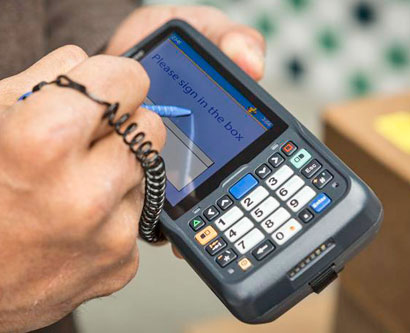On October 1st, 2013, Intermec, now part of Honeywell Scanning & Mobility, introduced the CN51 rugged mobile computer, ostensibly as a migration option to the by now over four years old CN50, but that's only part of the story. While follow-ups to successful products generally emphasize technology updates, the CN51 does that, but also quite a bit more. Like the ability to run either the longtime stalwart OS for industrial handhelds—Microsoft Windows Embedded Handheld— or the Android OS that's now installed on almost a billion smartphones.

That warrants a bit of commentary. There's the odd situation that while almost all smartphones are either iPhones or Android devices, virtually all industrial handhelds still run one version of Microsoft's old Windows CE or Windows Mobile or another. Which means that most industrial handhelds are by no means ruggedized equivalents of the smartphones a good part of humanity already knows inside out. Which results in extra training, an extra learning curve, and the near certainty that change will come anyway. Up to now, rugged mobile computing manufacturers have been remarkably conservative in acknowledging that trend, and generally limiting themselves to offering an exploratory Android version or two of a Windows device running on similar hardware. What we're now beginning to see is the next step, that of making the hardware so that it can run both old and new.
No one wants to alienate Microsoft, of course, and so things are worded carefully. In this case, the Intermec press release includes a quote from industry analyst David Krebs, VP of mobile & wireless at VDC: "While rugged devices are designed to be more function or application-specific than smartphones, there is growing consensus that these devices deliver a similar immersive experience and have similar capabilities as function-rich smartphones. As Android matures in the enterprise it represents an increasingly viable option for rugged vendors such as Intermec to bridge this functionality gap and deliver the capabilities their partners and customers are looking for."
Hence the CN51. It doesn't look much different from the CN50 it replaces, and it's even compatible with CN50 accessories and much of the CN50 infrastructure. But looks deceive as the platform has been reworked far more substantially than is usually the case with a tech update. The old CN50 screen, for example, was a smallish 3.5 inches and had the by now ancient 240 x 320 QVGA screen resolution. The new CN51 has a 4-inch screen, like the iPhone 5, and 480 x 800 pixel resolution. That's five times as many pixels. The digitizer has changed, too. Android pretty much requires multi-touch, and that's what the CN51 offers. But there's a compromise—since Windows Mobile really needs a stylus, Intermec settled on resistive multi-touch and not the smoother capacitive multitouch.
But how can two very different OS platforms run on the same hardware? Usually that's not possible, but there are processors that can handle both Windows Mobile and Android, and the OMAP 4470 from Texas Instruments is one of them. So that's what the CN51 uses, and it should be up to the job with dual cores running at 1.5GHz.
So that's the big news on the next generation of Intermec's workhorse mobile computer. But lots of other things have changed as well, mostly on the technical side. There's much more RAM and ROM (1GB and 16GB, respectively), and there's now a microSD card slot to add up to another 32GB. WiFi is much faster, as is Bluetooth, both benefitting from the latest versions. The same goes for mobile broadband where customers can benefit from either CDMA or UMTS data/voice-capable high-speed networks.
On the scanning side, the new CN51 is available with either Intermec's EA30 or EA31 1D/2D imager, and there's a higher-res 5-megapixel camera that, combined with image processing software, does Mobile Document Imaging (MDI) and Remote Deposit Capture (RDC) to quickly and reliably convert full-size paper documents or check payments into electronic files while on the road, transmitting directly from the point of capture to the back-office workflow.
In terms of size and weight, not much has changed. The CN51 measures 6.45 x 2.9 x 1.1 inches and weighs about 12 ounces, virtually the same as the old CN50. It can still survive 5-foot drops, operate in a wide temperature range of 14 to 122 degrees Fahrenheit, but it is now sealed to IP64 specifications, which means it's totally dustproof and can survive water spray from all directions.
Like the old CN50, the new CN51 is available with either a numeric or QWERTY backlit keypad. The device is powered, standard, by what used to be considered the extended battery that packs 3,900mAH, but does not add to the size of the device.
In summary, like its predecessor, the Intermec CN51 packs an awful lot of data capture, computing and communication functionality for mobile workers who rely on "hold & carry" customer interaction and appreciate a single device that combines all their needed tools into a single, rugged, compact package. But it now all comes in a greatly improved package, and one openly offers the option to do things the way they have been done for a decade and a half, or give the Android platform a shot and see how that might work out.
Below is Intermec's introductory CN51 video:



